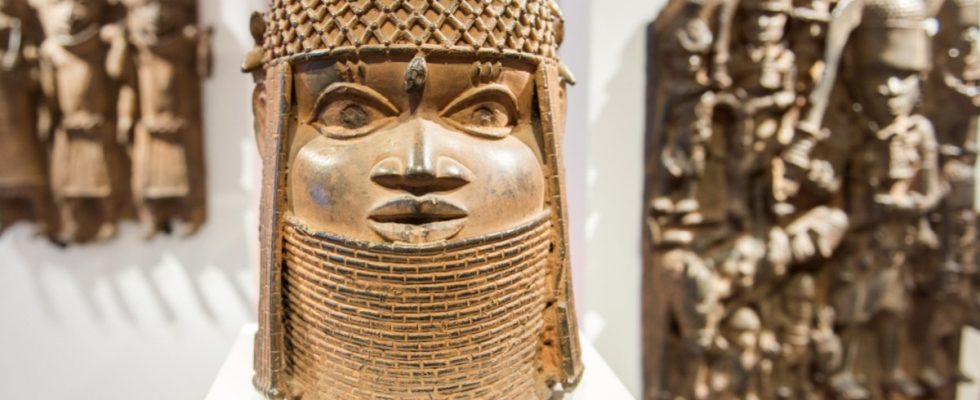The trail leads from the Rhineland directly to Benin, today’s Nigeria. It is about centuries-old, horseshoe-shaped brass rings and the secret of the production of the world-famous Benin bronzes. The valuable objects from the old West African kingdom of the Edo are at the center of intensive discussions about the return of colonial art. Now, chemical signatures in the metal, discovered by a German geochemist, show for the first time how, shortly after the end of the Middle Ages, the European and German metal industry, the beginning of the slave trade and the emergence of the Benin bronzes were interwoven.
At the center of the story are the so-called manillas, heavy, horseshoe-shaped and made of brass. Traded in the millions, they were the currency of the Portuguese slave trade in the 16th and 17th centuries. Again and again historians have expressed the assumption that European manillas from Great Britain, Germany or Scandinavia were used for the production of works of art from Benin. Now the Bochum geochemist Tobias Skowronek from the Technical University Georg Agricola has proven for the first time that the most important raw material brass actually comes from Europe and was very probably the central, maybe even the only source of raw materials for the West African foundry industry. Even more surprising: “The manillas were cast in the Rhineland,” says Skowronek. “They were then transported over 6,300 kilometers to Benin.” A real surprise that he and his research team published in the journal PLOS one released.
A manilla concreted to part of a Flemish trader’s pot.
(Photo: Ana Maria Benito-Dominguez/dpa)
The Benin bronzes are world-famous sculptures, objects and reliefs made of brass. A good 5,000 individual pieces are currently distributed across Europe’s museums, with around 1,000 pieces alone in German collections and depots. The Benin bronzes are considered a clear case of looted art. In 1897, in the course of a bloody “punitive expedition”, British colonial troops plundered the royal palace in Benin City in present-day Nigeria and took the art objects with them. Recently there have been initial commitments to return objects from German museums.
The current research work, which reveals more about the history of the creation of the objects, is all the more exciting. Tobias Skowronek says that he came across this topic as part of his doctoral thesis on global metal trading. “There were dizzying amounts of these manillas delivered,” says Skowronek. “And although these ripenings were so important in the slave trade between Europe and Africa, no one knew who made them and where it happened.” There were few historical documents, contracts between German brass producers and Portuguese or Spanish merchants. But mostly it was more about rings and clasps, it was not clear what exactly was being traded. Especially not whether the manillas were intended for trade with African countries.
So Skowronek began to look for the early manillas himself in museums in Europe, Africa and the USA. And he found what he was looking for: numerous pieces had been discovered in the wrecks of sunken ships off the coasts of Ghana, Portugal and Spain. He was allowed to take samples there and began to compare their metal signatures with those of the Benin bronzes.
At this point, one must take a brief excursion into metal fabrication. The manillas are made of brass, an alloy of copper and zinc. They were cast from three raw materials, zinc ore, copper and lead ore. Historical sources show: there were zinc ore deposits on the German-Belgian border in the Aachen area, the copper was then imported from the Mansfelder Land in Saxony-Anhalt, from Sweden, Slovakia or Cornwall, the lead ore was found in large quantities in the Northwest Eifel.
In principle, each region has its own chemical signature, but there are also similarities in the signatures of certain trace elements such as antimony, arsenic, nickel or bismuth or in the isotope data of lead for different deposits. “Basically, the methods are always elimination processes,” explains Skowronek. “Sometimes the data from deposits are on top of each other and it is difficult to separate them from each other. That has to be checked on a case-by-case basis.”
Apparently, the foundrymen at the royal family in Benin only wanted the Rhenish metal to produce the bronzes
So detective work. It turned out that the lead isotope ratios of the brass rings were the most suitable for determining the origin of the Benin bronzes. Skowronek’s team determined three different values for the lead isotopes 206, 207 and 208 in the mass spectrometer of the Bochum Mining Museum and compared them with the Benin data. “If only two values match, but the third does not, this is not sufficient for an exact determination of origin,” explains the geochemist.
More than 700 chemical analyzes and 200 lead isotope data from Benin bronzes, which were available from the precious works of art, served as a reference. “We were very fortunate to have this large database of Benin material,” says Skowronek. And even more so, the clear and surprising result: the team found that the early manillas from the 16th and 17th centuries were very similar to the signatures of the Benin bronzes. They agree well with the isotope values of the lead-zinc ores of the German Rhineland. This makes it very likely that the manillas of the Portuguese ships examined overall were manufactured by the well-established Rhenish brass industry. “So there is no question that this material was actually used to create the Benin artworks,” says Skowronek.
The finding was also surprising because the foundrymen at the royal house in Benin apparently only wanted Rhenish metal, says Skowronek. “British and Scandinavian manillas bear no resemblance to Benin metal.” Apparently, the African craftsmen at the Edo royal court were very aware of the better casting properties of Rhenish products.

